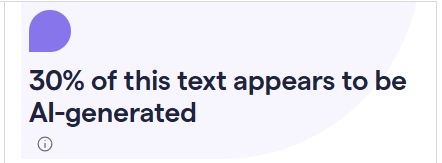Why AI Content Detection Is Hurting Your Marketing and the way to check the results to get much better SEO results

AI-generated content detection isn’t just about weeding out spam—it’s about maintaining quality and trust. Search engines and social platforms are in a constant battle against low-quality, mass-produced content that adds little value. The rise of AI writing tools has triggered a wave of automated content, making detection algorithms stricter. Always add a human side to the tin men.
Here’s why your content might be getting flagged:
- Overuse of AI-generated phrasing – AI tends to use predictable patterns, which detection algorithms recognize.
- Lack of originality – If your content sounds robotic or lacks personal touches, it screams AI.
- Poor engagement metrics – Content that doesn’t elicit real engagement (likes, comments, shares) signals low quality.
- Absence of human editing – AI can generate great drafts, but raw output often lacks a natural human touch.
Understanding these issues is the first step in fixing them. Now, let’s talk solutions.
How to Fix AI Content Detection Issues
Fixing AI detection problems isn’t about abandoning AI—it’s about using it strategically. Here’s how:
1. Blend AI with Human Creativity
AI should be a tool, not a replacement. Use AI for research, outlines, and drafts, but infuse your personal voice, insights, and real-life examples into the content. Edit every piece manually before publishing. Add your history about flagging results and poor performance
2. Vary Sentence Structure and Tone
AI tends to produce uniform sentence structures. Break this up by adding rhetorical questions, humor, storytelling, and varied sentence lengths. This makes the content feel more human. SEO tools love transition words with a positive spin. try to include these in all your writing
3. Add Personal Experiences and Opinions
AI doesn’t have your experiences. Inject your unique perspective, case studies, and real-world stories. This makes the content valuable and harder for detection algorithms to flag as AI-generated. Test your text against the machines and see the result.
4. Optimize for Engagement
Platforms prioritize content that gets engagement. Encourage comments, shares, and discussions. Use open-ended questions, ask for opinions, and create interactive content. I always add an about-me piece to my work so they know the writer and direction.
5. Use AI Detection Tools Before Publishing
Run your content through AI detection checkers like Originality.ai, GPTZero, or Copyleaks. If it’s flagged as AI-heavy, tweak it further. However be warned that these vary in results. I tend to rely on Grammarly
The Future of AI in Marketing – Adapt or Get Left Behind
AI is here to stay, but the game is changing. Marketers who rely solely on AI-written content will face increasing challenges. The winners will be those who know how to blend AI’s efficiency with human creativity.
Want to master AI for marketing without getting penalized? Michael Cheney’s AI Millionaire program teaches you how to leverage AI the right way—without falling into detection traps.

Don’t let AI detection kill your marketing campaigns. Learn how to work with AI, not against it. Join AI Millionaire now and future-proof your marketing!
Why AI Content Detection Is Hurting Your Marketing by Peter Hanleey and AI
Peter Hanley – Entrepreneur & Affiliate Marketing Mentor
A lifetime in business has taught me what works—and what doesn’t. Now, in semi-retirement, I focus on affiliate marketing and helping others build their own success online. Whether you’re starting fresh or refining your strategy, I’m here to guide the way.
More reading;
